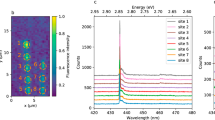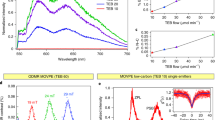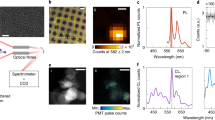Abstract
The colour centre platform holds promise for quantum technologies, and hexagonal boron nitride has attracted attention due to the high brightness and stability, optically addressable spin states and wide wavelength coverage discovered in its emitters. However, its application is hindered by the typically random defect distribution and complex mesoscopic environment. Here, employing cathodoluminescence, we demonstrate on-demand activation and control of colour centre emission at the twisted interface of two hexagonal boron nitride flakes. Further, we show that colour centre emission brightness can be enhanced by two orders of magnitude by tuning the twist angle. Additionally, by applying an external voltage, nearly 100% brightness modulation is achieved. Our ab initio GW and GW plus Bethe–Salpeter equation calculations suggest that the emission is correlated to nitrogen vacancies and that a twist-induced moiré potential facilitates electron–hole recombination. This mechanism is further exploited to draw nanoscale colour centre patterns using electron beams.
This is a preview of subscription content, access via your institution
Access options
Access Nature and 54 other Nature Portfolio journals
Get Nature+, our best-value online-access subscription
$29.99 / 30 days
cancel any time
Subscribe to this journal
Receive 12 print issues and online access
$259.00 per year
only $21.58 per issue
Buy this article
- Purchase on Springer Link
- Instant access to full article PDF
Prices may be subject to local taxes which are calculated during checkout





Similar content being viewed by others
Data availability
All data are available in the main text or the Supplementary Information.
References
Aharonovich, I., Englund, D. & Toth, M. Solid-state single-photon emitters. Nat. Photon. 10, 631–641 (2016).
de Leon, N. P. et al. Materials challenges and opportunities for quantum computing hardware. Science 372, eabb2823 (2021).
Tran, T. T., Bray, K., Ford, M. J., Toth, M. & Aharonovich, I. Quantum emission from hexagonal boron nitride monolayers. Nat. Nanotechnol. 11, 37–41 (2016).
Grosso, G. et al. Tunable and high-purity room temperature single-photon emission from atomic defects in hexagonal boron nitride. Nat. Commun. 8, 705 (2017).
Kianinia, M. et al. Robust solid-state quantum system operating at 800 K. ACS Photonics 4, 768–773 (2017).
Gottscholl, A. et al. Initialization and read-out of intrinsic spin defects in a van der Waals crystal at room temperature. Nat. Mater. 19, 540–545 (2020).
Chejanovsky, N. et al. Single-spin resonance in a van der Waals embedded paramagnetic defect. Nat. Mater. 20, 1079–1084 (2021).
Shevitski, B. et al. Blue-light-emitting colour centres in high-quality hexagonal boron nitride. Phys. Rev. B 100, 155419 (2019).
Museur, L., Feldbach, E. & Kanaev, A. Defect-related photoluminescence of hexagonal boron nitride. Phys. Rev. B 78, 155204 (2008).
Bourrellier, R. et al. Bright UV single photon emission at point defects in h-BN. Nano Lett. 16, 4317–4321 (2016).
Vuong, T. Q. P. et al. Phonon-photon mapping in a colour centre in hexagonal boron nitride. Phys. Rev. Lett. 117, 097402 (2016).
Tran, T. T. et al. Robust multicolour single photon emission from point defects in hexagonal boron nitride. ACS Nano 10, 7331–7338 (2016).
Jungwirth, N. R. & Fuchs, G. D. Optical absorption and emission mechanisms of single defects in hexagonal boron nitride. Phys. Rev. Lett. 119, 057401 (2017).
Hayee, F. et al. Revealing multiple classes of stable quantum emitters in hexagonal boron nitride with correlated optical and electron microscopy. Nat. Mater. 19, 534–539 (2020).
Anzai, Y. et al. Broad range thickness identification of hexagonal boron nitride by colours. Appl. Phys. Express 12, 055007 (2019).
Taylor, J. M. et al. High-sensitivity diamond magnetometer with nanoscale resolution. Nat. Phys. 4, 810–816 (2008).
Sajid, A., Ford, M. J. & Reimers, J. R. Single-photon emitters in hexagonal boron nitride: a review of progress. Rep. Prog. Phys. 83, 044501 (2020).
Son, J. et al. Atomically precise graphene etch stops for three dimensional integrated systems from two dimensional material heterostructures. Nat. Commun. 9, 3988 (2018).
Proscia, N. V. et al. Near-deterministic activation of room-temperature quantum emitters in hexagonal boron nitride. Optica 5, 1128–1134 (2018).
Geiselmann, M., Marty, R., García De Abajo, F. J. & Quidant, R. Fast optical modulation of the fluorescence from a single nitrogen-vacancy centre. Nat. Phys. 9, 785–789 (2013).
Khatri, P., Ramsay, A. J., Malein, R. N. E., Chong, H. M. H. & Luxmoore, I. J. Optical gating of photoluminescence from colour centres in hexagonal boron nitride. Nano Lett. 20, 4256–4263 (2020).
Cao, Y. et al. Correlated insulator behaviour at half-filling in magic-angle graphene superlattices. Nature 556, 80–84 (2018).
Cao, Y. et al. Unconventional superconductivity in magic-angle graphene superlattices. Nature 556, 43–50 (2018).
Sharpe, A. L. et al. Emergent ferromagnetism near three-quarters filling in twisted bilayer graphene. Science 365, 605–608 (2019).
Seyler, K. L. et al. Signatures of moiré-trapped valley excitons in MoSe2/WSe2 heterobilayers. Nature 567, 66–70 (2019).
Lee, H. Y. et al. Tunable optical properties of thin films controlled by the interface twist angle. Nano Lett. 21, 2832–2839 (2021).
Tran, K. et al. Evidence for moiré excitons in van der Waals heterostructures. Nature 567, 71–75 (2019).
Jin, C. et al. Observation of moiré excitons in WSe2/WS2 heterostructure superlattices. Nature 567, 76–80 (2019).
Woods, C. R. et al. Charge-polarized interfacial superlattices in marginally twisted hexagonal boron nitride. Nat. Commun. 12, 347 (2021).
Yasuda, K., Wang, X., Watanabe, K., Taniguchi, T. & Jarillo-Herrero, P. Stacking-engineered ferroelectricity in bilayer boron nitride. Science 372, 1458–1462 (2021).
Yao, K. et al. Enhanced tunable second harmonic generation from twistable interfaces and vertical superlattices in boron nitride homostructures. Sci. Adv. 7, abe8691 (2021).
Ribeiro-Palau, R. et al. Twistable electronics with dynamically rotatable heterostructures. Science 361, 690–693 (2018).
Yang, Y. et al. In situ manipulation of van der Waals heterostructures for twistronics. Sci. Adv. 6, abd3655 (2020).
Hybertsen, M. S. & Louie, S. G. Electron correlation in semiconductors and insulators: band gaps and quasiparticle energies. Phys. Rev. B 34, 5390–5413 (1986).
Rohlfing, M. & Louie, S. G. Electron-hole excitations and optical spectra from first principles. Phys. Rev. B 62, 4927–4944 (2000).
Katzir, A., Suss, J. T., Zunger, A. & Halperin, A. Point defects in hexagonal boron nitride. I. EPR, thermoluminescence, and thermally-stimulated-current measurements. Phys. Rev. B 11, 2370–2377 (1975).
Yoo, H. et al. Atomic and electronic reconstruction at the van der Waals interface in twisted bilayer graphene. Nat. Mater. 18, 448–453 (2019).
Watanabe, K., Taniguchi, T. & Kanda, H. Direct-bandgap properties and evidence for ultraviolet lasing of hexagonal boron nitride single crystal. Nat. Mater. 3, 404–409 (2004).
Wu, J. et al. Raman spectroscopy and time-resolved photoluminescence of BN and BxCyNz nanotubes. Nano Lett. 4, 647–650 (2004).
Du, X. Z., Li, J., Lin, J. Y. & Jiang, H. X. The origin of deep-level impurity transitions in hexagonal boron nitride. Appl. Phys. Lett. 106, 021110 (2015).
Watanabe, K. & Taniguchi, T. Far-UV photoluminescence microscope for impurity domain in hexagonal-boron-nitride single crystals by high-pressure, high-temperature synthesis. npj 2D Mater. Appl. 3, 40 (2019).
Hamdi, H., Thiering, G., Bodrog, Z., Ivády, V. & Gali, A. Stone–Wales defects in hexagonal boron nitride as ultraviolet emitters. npj Comput. Mater. 6, 178 (2020).
Mackoit-Sinkevičienė, M., Maciaszek, M., Van de Walle, C. G. & Alkauskas, A. Carbon dimer defect as a source of the 4.1 eV luminescence in hexagonal boron nitride. Appl. Phys. Lett. 115, 212101 (2019).
Refaely-Abramson, S., Qiu, D. Y., Louie, S. G. & Neaton, J. B. Defect-induced modification of low-lying excitons and valley selectivity in monolayer transition metal dichalcogenides. Phys. Rev. Lett. 121, 167402 (2018).
Pankove, J. I. & Kiewit, D. A. Optical Processes in Semiconductors (Dover Publications, 2012); https://doi.org/10.1149/1.2404256
Moore, A. W. & Singer, L. S. Electron spin resonance in carbon-doped boron nitride. J. Phys. Chem. Solids 33, 343–356 (1972).
Rousseau, A. et al. Determination of the optical bandgap of the Bernal and rhombohedral boron nitride polymorphs. Phys. Rev. Mater. 5, 064602 (2021).
Pelini, T. et al. Shallow and deep levels in carbon-doped hexagonal boron nitride crystals. Phys. Rev. Mater. 3, 094001 (2019).
Tawfik, S. A. et al. First-principles investigation of quantum emission from hBN defects. Nanoscale 9, 13575–13582 (2017).
Museur, L. & Kanaev, A. Photoluminescence properties of pyrolytic boron nitride. J. Mater. Sci. 44, 2560–2565 (2009).
Sajid, A., Reimers, J. R. & Ford, M. J. Defect states in hexagonal boron nitride: assignments of observed properties and prediction of properties relevant to quantum computation. Phys. Rev. B 97, 064101 (2018).
Wang, L. et al. One-dimensional electrical contact to a two-dimensional material. Science 342, 614–617 (2013).
Zomer, P. J., Guimarães, M. H. D., Brant, J. C., Tombros, N. & Van Wees, B. J. Fast pick up technique for high quality heterostructures of bilayer graphene and hexagonal boron nitride. Appl. Phys. Lett. 105, 013101 (2014).
Giannozzi, P. et al. QUANTUM ESPRESSO: a modular and open-source software project for quantum simulations of materials. J. Phys. Condens. Matter 21, 395502 (2009).
Tiago, M. L., Ismail-Beigi, S. & Louie, S. G. Effect of semicore orbitals on the electronic band gaps of Si, Ge, and GaAs within the GW approximation. Phys. Rev. B 69, 125212 (2004).
Deslippe, J. et al. BerkeleyGW: a massively parallel computer package for the calculation of the quasiparticle and optical properties of materials and nanostructures. Comput. Phys. Commun. 183, 1269–1289 (2012).
Hovington, P., Drouin, D. & Gauvin, R. CASINO: a new Monte Carlo code in C language for electron beam interaction—part I: description of the program. Scanning 19, 1–14 (1997).
Kanaya, K. & Okayama, S. Penetration and energy-loss theory of electrons in solid targets. J. Phys. D 5, 43–58 (1972).
Acknowledgements
This work was supported primarily by the US Department of Energy, Office of Science, Basic Energy Sciences, Materials Sciences and Engineering Division under contract no. DE-AC02-05-CH11231, within the sp2-Bonded Materials Program (KC2207), which provided for the development of the project concept and theoretical calculations. CL and HRTEM measurements were provided by The Molecular Foundry, supported under the US Department of Energy, Office of Science, Basic Energy Sciences, Materials Sciences and Engineering Division under contract no. DE-AC02-05-CH11231. Additional support was provided by the US Department of Energy, Office of Science, Basic Energy Sciences, Materials Sciences and Engineering Division under contract no. DE-AC02-05-CH11231, within the van der Waals Bonded Materials Program (KCWF16), which provided for sample fabrication, and within the Theory of Materials Program, which provided theoretical methods and analyses. Preparation of the TEM grid suspended samples was provided by the National Science Foundation under grant DMR-1807322. C.S. gratefully acknowledges the financial support of a Kavli Energy NanoScience Institute Heising-Simons Postdoctoral Fellowship. K.W. and T.T. acknowledge support from the Elemental Strategy Initiative conducted by the MEXT, Japan (grant no. JPMXP0112101001) and the Japan Society for the Promotion of Science KAKENHI (grant nos 19H05790 and JP20H00354). W.Z. and F.Z. acknowledge the support from the Guangdong Innovation Research Team Project (no. 2017ZT07C062), Guangdong Provincial Key-Lab programme (no. 2019B030301001), Shenzhen Municipal Key-Lab programme (ZDSYS20190902092905285) and Centre for Computational Science and Engineering at Southern University of Science and Technology. J.-H.P. and J.K. acknowledge the support from the US Army Research Office Multidisciplinary University Research Initiative under grant no. W911NF-18-1-0431 and the US Army Research Office through the Institute for Soldier Nanotechnologies at MIT, under cooperative agreement no. W911NF-18-2-0048.
Author information
Authors and Affiliations
Contributions
C.S., A.Z. and S.A. conceived the experiments. A.Z. supervised the whole project. S.G.L. supervised the theoretical studies. C.S. and S.A. designed and performed the regular, in situ and cryo-CL and HRTEM experiments. F.Z. performed the calculations and, with J.J. and S.G.L., performed the theory analyses. S.K. prepared the samples and fabricated the devices. C.D. and A.U. aided in sample preparations. J.-H.P. and J.K. prepared the monolayer hBN samples. K.W. and T.T. provided the bulk hBN samples. C.S. wrote the paper. All the authors were involved in the paper revisions.
Corresponding authors
Ethics declarations
Competing interests
The authors declare no competing interests.
Peer review
Peer review information
Nature Materials thanks Sajid Ali and the other, anonymous, reviewer(s) for their contribution to the peer review of this work.
Additional information
Publisher’s note Springer Nature remains neutral with regard to jurisdictional claims in published maps and institutional affiliations.
Supplementary information
Supplementary Information
Supplementary Figs. 1–13, Table 1 and Discussion.
Rights and permissions
About this article
Cite this article
Su, C., Zhang, F., Kahn, S. et al. Tuning colour centres at a twisted hexagonal boron nitride interface. Nat. Mater. 21, 896–902 (2022). https://doi.org/10.1038/s41563-022-01303-4
Received:
Accepted:
Published:
Issue Date:
DOI: https://doi.org/10.1038/s41563-022-01303-4
This article is cited by
-
Dynamic multicolor emissions of multimodal phosphors by Mn2+ trace doping in self-activated CaGa4O7
Nature Communications (2024)
-
Exceptionally strong coupling of defect emission in hexagonal boron nitride to stacking sequences
npj 2D Materials and Applications (2024)
-
Atomically precise engineering of spin–orbit polarons in a kagome magnetic Weyl semimetal
Nature Communications (2024)
-
Engineered interfaces for heterostructured intermetallic nanomaterials
Nature Synthesis (2023)
-
Evolution of nanopores in hexagonal boron nitride
Communications Chemistry (2023)



